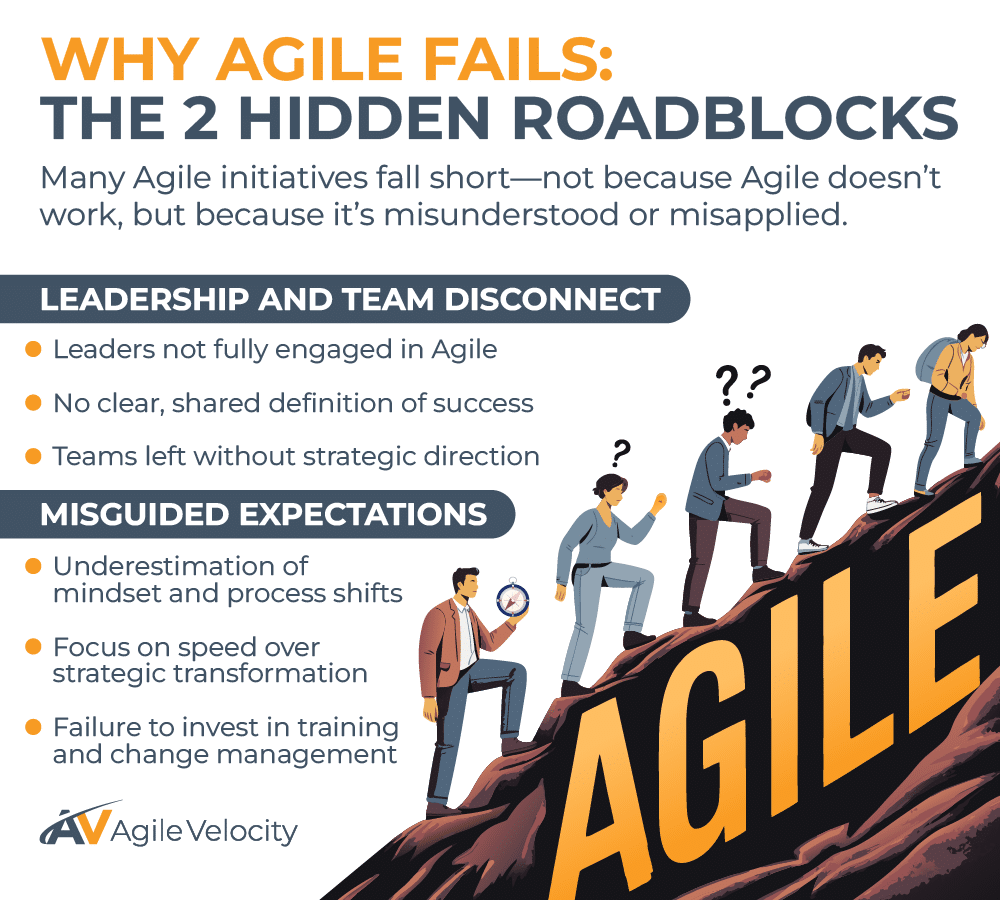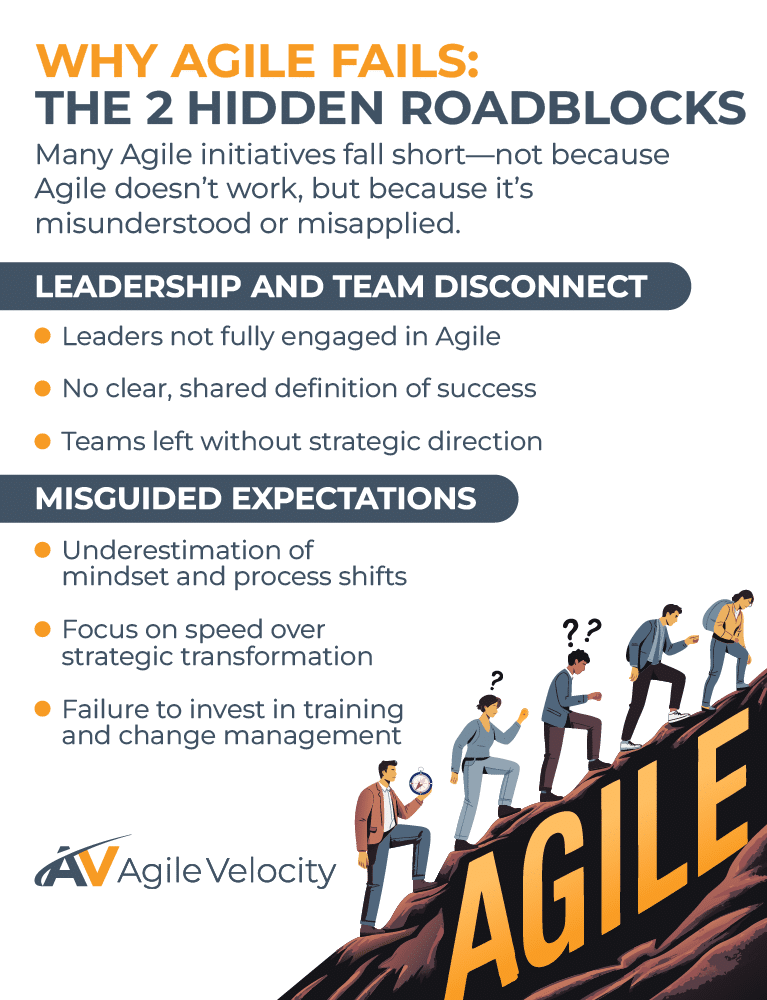Selecting the right business consulting partner can be a game-changer for organizations striving to embrace sustainable agility. For many leaders, past Agile initiatives may have fallen short, leaving behind frustration, misaligned workflows, or the belief that “Agile just doesn’t work for us.” These setbacks often stem from poorly guided implementations, rather than Agile Practices failing to deliver. Choosing an experienced consulting partner who focuses on measurable outcomes can help organizations turn these missteps into meaningful progress.
This article explores why many organizations struggle to realize Agile’s true benefits, identifies the key traits of an effective Agile advisory partner, and highlights how tools like Path to Agility® Navigator can drive clarity and long-term success. Whether you’re revisiting Agile practices and principles after prior challenges or exploring it as a new strategic approach, this guide provides actionable insights to help you move forward with confidence.
The Importance of Choosing the Right Business Consulting Partner
In recent years, Agile has become a popular approach for organizations seeking to improve adaptability and speed in delivering value. However, not all Agile initiatives yield the desired results. Many businesses walk away from their initial attempts because they didn’t obtain the benefits of Agile. Often, this conclusion stems not from Agile itself but from poor implementation or a lack of proper guidance.
Two primary challenges frequently contribute to underwhelming Agile experiences:
- Disconnect between leadership and teams: Teams often struggle with alignment when leaders aren’t actively involved or fail to communicate a shared vision of success.
- Misguided expectations: Many organizations adopt Agile without fully understanding the effort required to shift their processes, priorities, and mindsets.
When these missteps occur, leaders might see surface-level changes—such as the adoption of Agile events or terminology—without meaningful shifts in how teams collaborate, prioritize, and deliver. This gap creates frustration, delays, and limited improvements in efficiency or quality, ultimately leading to skepticism about Agile’s value.
The right Agile adoption and implementation business consultant can reverse these dynamics by addressing the root causes of failure. Effective partners spotlight the bigger picture, going beyond frameworks like Scrum, Kanban, or Extreme Programming (XP). They look at your organization holistically, exploring leadership behavior, alignment with Lean principles, and readiness for continuous improvement or lean portfolio management.
Rather than simply implementing Agile practices, a strong consulting partner prioritizes business outcomes. They guide your organization toward synchronized process, cultural, and leadership changes that foster true organizational agility. This comprehensive approach ensures Agile becomes a growth enabler, not just another new methodology.
Why Successful Agile Business Transformations Matter
Achieving a successful business transformation can revolutionize an organization’s operational landscape, transcending beyond mere improvements in software delivery. This approach is pivotal in driving continuous improvement, fostering adaptability, and enhancing team alignment across strategic objectives. Likewise, a well-executed Agile business transformation integrates critical elements of Agile, creating a vibrant ecosystem where every team member understands their role in the larger organizational mission. Here are the key reasons why these transformations are vital:
- Predictable Value Delivery: Agile enables teams to deliver consistent, measurable value through shorter feedback loops and iterative development processes. For example, implementing structured iterative cycles like Sprint Planning, Daily Scrums, Sprint Review, Sprint Retrospectives provides a framework for continuous improvement and adaptability.
- Adaptability to Change: By utilizing frameworks such as the Scaled Agile Framework® (SAFe®), organizations can swiftly pivot in response to evolving market demands or unexpected challenges. This agility ensures that businesses remain competitive and ready to address new opportunities or obstacles.
- Improved Morale and Engagement: Agile Transformations encourage teams to connect their daily tasks with broader strategic goals. This understanding fosters a sense of purpose and strengthens communication channels, bolstering team morale and engagement.
- Operational Excellence: Emphasizing continuous improvement at all levels pushes organizations towards better systems, enhanced processes, and superior outcomes. This focus on excellence ensures long-term sustainability and growth.
- Meaningful Business Results: Agile Transformation isn’t just about adopting a methodology; it focuses on achieving substantial business outcomes. Whether using frameworks like SAFe, Scrum@Scale or Large-Scale Scrum (LeSS), or crafting a tailored solution, the transformation should aim to align with pragmatic organizational goals, thus driving tangible results.
In summary, successful transformations are crucial for unlocking the full potential of agility within a business. They provide the tools and frameworks necessary to avoid past missteps and set a foundation for thriving in a dynamic environment. By engaging with a knowledgeable consulting partner, businesses can experience a profound shift in their operations, enabling teams to execute strategic initiatives effectively and driving substantial business success.
Assessing the Business Value of Agile Coaching
Agile coaching plays a pivotal role in helping organizations foster the behaviors, mindsets, and practices needed to achieve true agility. While Agile Methodologies provide the framework, it’s the guidance of an experienced coach that ensures these frameworks are applied effectively, driving transformative, long-lasting change.
Transforming Leadership Perspectives
A major focus of Agile coaching is shifting leadership mindsets so that they align with Agile principles. Leaders, such as Product Owners or Agile Project Management Office, often need to adopt new approaches to prioritization, team alignment, and decision-making. Coaches work closely with leadership to:
- Adapt traditional management styles to those that prioritize responsiveness, empowerment, and collaboration.
- Overcome outdated habits that hinder progress.
- Emphasize strategic alignment by ensuring leaders set achievable goals and inspire teams to deliver measurable value.
By helping leaders model Agile behaviors, coaches build a foundation that supports an organization-wide transformation—functioning as a trusted partner in reshaping the future of work.
Strengthening Team Connections and Collaboration
Agile coaching is instrumental in breaking down silos and creating an environment where cross-functional collaboration thrives. Whether it’s engineering, marketing, compliance, or operations, coaches unite diverse teams by:
- Addressing underlying tensions and fostering open, productive communication.
- Refining team practices like backlog refinement, establishing actionable Sprint Goals, or optimizing Kanban’s WIP Limits.
- Encouraging shared ownership of outcomes and establishing clear accountability across departments.
Such collaborative efforts ensure that all departments work together cohesively, aligning their efforts with the organization’s broader goals.
Enhancing Cultural and Technical Adaptability
True agility isn’t solely about rigid process implementation—it’s also about a cultural and technical shift. Coaches guide teams through both technical upgrades and human-centric transformations, ensuring that organizations adjust holistically. This includes:
- Strengthening technical practices such as test-driven development, continuous integration, and regular iteration-based feedback loops.
- Reinforcing cultural shifts that encourage transparency, experimentation, and iterative improvement at every level.
- Bridging technical changes to larger cultural shifts so that every initiative contributes to business transformation.
Reframing Past Challenges into Growth Opportunities
For organizations skeptical about Agile because of previous unsuccessful attempts, Agile coaching provides the clarity and direction needed to reset the course. Coaches help reframe past shortcomings by:
- Identifying specific areas where earlier Agile initiatives went wrong—be it unclear goals, mismanaged expectations, or poor execution.
- Rebuilding trust by demonstrating how small, incremental wins can accumulate into significant, measurable outcomes.
- Encouraging teams to learn from mistakes, iterate on their processes, and reengage with Agile practices more effectively.
Such a perspective enables teams to regain faith in Agile and fully commit to its transformative power.
Steps for Evaluating and Choosing the Right Agile Partner

Choosing the right Agile consulting partner is fundamental to laying a solid foundation for your Agile Transformation. To ensure you select a partner that aligns with your organization’s objectives, follow these actionable steps:
- Define Your Organization’s Transformation Objectives: Before engaging any potential partner, clarify your goals. Are you aiming to accelerate delivery, improve cross-functional collaboration, or implement a cultural shift? Precise objectives will help you gauge which partner is best equipped to deliver the desired outcomes.
- Examine Experience and Proven Expertise: Review potential partners’ track records by considering:
- Their hands-on experience with frameworks such as Scrum, SAFe, or Large-Scale Scrum (LeSS).
- Their exposure to enterprise-level transformations, including scaling Agile across multiple teams.
- Client case studies or success stories that align with your industry and objectives.
- Assess Their Approach to Customization: Beware of cookie-cutter methodologies. Instead, search for partners who tailor Agile practices to your company’s structure, culture, and strategic goals. Ask how they plan to adapt strategies to fit your unique needs.
- Evaluate Their Technology and Tooling Capabilities: Confirm that the partner can successfully integrate industry-leading tools—such as Path to Agility Navigator—that offer actionable insights, progress tracking, and data visualizations to support your transformation.
- Prioritize Collaboration and Transparency: The right partner acts as a collaborative teammate. Look for clear discussions regarding roles, responsibilities, and outcomes, and expect them to use real-time feedback loops and Agile events to ensure alignment. This level of openness is key in a long-term partnership.
- Review Testimonials and Client References: Learn from other organizations’ experiences by reviewing client testimonials and requesting references. Ask about how effectively the partner addressed challenges, tailored solutions to unique needs, and ensured sustained improvements after their engagement.
Choosing the right Agile partner requires careful consideration of both their expertise and their ability to align with your organizational goals. By diligently evaluating factors such as customization capabilities, communication styles, and technical proficiencies, businesses can forge a partnership that not only supports their Agile journey but also amplifies its success. Engaging with the right partner will empower your teams to drive meaningful, transformative change, meeting both immediate needs and long-term objectives.
5 Key Qualities to Look for in a Business Consulting Partner for Agile Success

Selecting an Agile consulting partner is a pivotal decision that can determine the success or failure of your Agile Transformation. The right partner not only introduces practices but also tailors their approach to your unique challenges and goals, ensuring measurable business outcomes. Below are the key qualities to prioritize when evaluating potential partners.
1) Prioritizes Outcomes Over Frameworks
A strong consulting partner focuses on delivering results instead of rigidly adhering to specific frameworks. While tools like Scrum, SAFe, or Kanban are valuable, no single framework works universally. Effective partners understand this and adapt processes to align with your organization’s specific needs. Look for a team that:
- Crafts solutions based on your business context, goals, and culture rather than a one-size-fits-all framework.
- Tracks and communicates tangible outcomes, such as improved delivery times, higher-quality outputs, or reduced inefficiencies.
- Guides leadership and teams through meaningful changes—shifting behaviors, aligning priorities, and fostering an Agile mindset.
2) Expertise in Tailoring Agile
Agile Methodologies are expansive, encompassing practices like Sprints, Lean Portfolio Management, and continuous flow. Successful consultants know how to fine-tune these approaches to fit the maturity and complexity of your organization. An experienced partner might adjust key elements like Sprint Planning, Daily Scrum, and Sprint Retrospectives to work seamlessly within your teams. They can also guide you in scaling practices—for example, by coordinating Agile Release Trains (ARTs)—to ensure agility at all levels. In doing so, they serve not just as advisors but as a true Agile transformation partner in every sense.
3) Committed to Transparency, Data, and Collaboration
Transparency and collaboration are indispensable for a successful Agile Transformation. The right consulting partner sets an example of openness by fostering clear communication and data-driven insights. They should:
- Encourage open dialogue between leadership and teams, enabling the exchange of candid feedback.
- Utilize metrics such as velocity, throughput, defect rate, or Work In Progress (WIP) Limits to measure progress and align improvements with business goals.
- Promote shared accountability by engaging stakeholders at all levels and ensuring alignment across the organization.
4) Proven Success at Enterprise Scale
Applying Agile principles within a small team is one thing; scaling these practices across a complex enterprise is another. If your organization operates at a large scale, your consulting partner must have verifiable experience handling enterprise-level challenges. They should be capable of:
- Navigating large-scale dependencies and aligning cross-functional teams and departments.
- Implementing enterprise frameworks like SAFe or Scrum@Scale™ to manage multiple teams and priorities effectively.
- Guiding leadership in defining Planning Interval (PI) Objectives and aligning them with broader business strategies.
- Integrating roles like Business Owners and Product Owners into Agile team dynamics, ensuring strategic alignment and efficient decision-making.
5) Focus on Building a Culture of Continuous Improvement
True organizational agility extends far beyond implementing Agile. An exceptional consulting partner helps embed a culture in which teams and leaders continuously learn, adapt, and improve. This requires:
- Coaching leaders to embrace Agile not just as a tool, but as a mindset that drives ongoing growth and innovation.
- Providing long-term enablement tools—such as nurturing internal Agile coaching capabilities—to empower teams to sustain improvements independently.
- Ensuring that employees at all levels understand the “why” behind Agile, fostering deeper engagement and alignment.
The Role of Tools and Frameworks in Agile Transformations
The success of an Agile Transformation often hinges on selecting the right tools and frameworks to support organizational change. While frameworks offer a structured approach for implementing Agile practices, tools provide the visibility and data required to track progress, identify challenges, and maintain momentum.
Leveraging Path to Agility Navigator for Success
One powerful tool that empowers organizations is Path to Agility Navigator. It offers:
- Clarity on inefficiencies by mapping out bottlenecks and gaps within workflows.
- Alignment with business goals through visual connections between day-to-day efforts and broader strategies.
- The ability to track progress and optimize processes through key milestones—all of which can be vital for a robust Agile Transformation.
Watch the video below to learn more about how Path to Agility Navigator can help your business achieve agility:
Scaling Agility with Frameworks
As organizations grow, frameworks become essential for managing complexity without losing focus. Models such as the Scaled Agile Framework (SAFe), Scrum@Scale, Large-Scale Scrum (LeSS), or Disciplined Agile® (DA™) provide the structure needed to keep teams aligned and processes adaptable. For example, these frameworks help coordinate Agile Release Trains (ARTs) and set Planning Interval (PI) Objectives that tie directly to high-priority business outcomes.
Empowering Agility Through Technology
In larger organizations, technology unifies teams, automates processes, and brings transparency to progress. Digital tools like Kanban Boards or project tracking solutions help teams visualize workflows, monitor important metrics (such as throughput or velocity), and enhance Lean principles. This technological support—coupled with frameworks and expert guidance from a seasoned Agile consulting partner—ensures that inefficiencies are removed and progress remains sustainable.
How Agile Consulting Drives Organizational Transformation and Operational Excellence
Agile consulting serves as a catalyst for organizations aiming for sustainable transformation and operational excellence. It does more than implement frameworks or processes—it fosters a mindset of adaptability, continuous improvement, and strategic alignment. Here are a few ways Agile consulting adds value:
Improved Delivery Predictability
By aligning teams around iterative cycles—using practices such as Sprint Planning, Daily Scrum, and clearly defined Sprint Goals—organizations can reduce unpredictability and risk.
Focused Alignment With Strategic Goals
Operational excellence comes from connecting everyday tasks to broad business objectives. Techniques like Lean Portfolio Management ensure resources are directed toward high-priority initiatives, driving long-term competitive advantage.
Enhanced Employee Engagement and Collaboration
By creating environments where team members truly understand how their contributions impact the organization, Agile practices spur improved morale, stronger collaboration, and shared accountability.
Accelerated Business Transformation
Agile consulting bridges the gap between strategy and execution, aligning executive leadership, department managers, and on-the-ground teams. The results are faster adaptation to market dynamics and better holistic performance.
Sustained Continuous Improvement
By embedding regular feedback loops (like Sprint Retrospective sessions), organizations can refine processes and drive continuous improvement—ensuring that the transformative insights of your consulting partner persist well after the initial engagement.
Creating Sustainable Agility Within Your Organization

Achieving sustainable agility goes beyond implementing processes or adopting frameworks—it’s about embedding a mindset of adaptability and continuous improvement into the organizational fabric. Leadership, ongoing education, and internal empowerment play critical roles in making Agile last.
Ensuring Leadership Commitment and Ongoing Learning
Leadership buy-in is the cornerstone of a successful Agile Transformation. Leaders champion Agile principles and cultivate a culture that embraces change by:
- Actively endorsing Agile methods and participating in key Agile events, including regular reflection sessions.
- Investing in education and training opportunities—from executive sessions on Organizational Agility to role-specific development for Scrum Masters and Product Owners.
Developing Internal Expertise for Long-Term Success
Sustainable agility is built when internal teams are empowered to drive change independently. Strategies include:
- Establishing Agile champions who can mentor and support continuous improvement.
- Creating peer-learning opportunities where experiences, lessons, and innovations are shared.
- Building internal coaching capacity to ensure that momentum is maintained even after external consulting has ended.
Embedding a Culture of Continuous Improvement
A culture that prizes continuous learning and improvement forms the backbone of sustainable agility. This involves:
- Encouraging regular reflection and iterative adjustments.
- Ensuring daily practices align with strategic business objectives.
- Recognizing and celebrating progress—reinforcing that every improvement, however small, is a step toward long-term success.
By aligning leadership, teams, and strategies, organizations achieve a level of adaptability and operational excellence that endures well beyond any single initiative.
Build a Roadmap to Agile Excellence with the Help of a Business Consultant
Selecting the right Agile consulting partner is the cornerstone of a successful, long-lasting transformation. By prioritizing measurable outcomes, tailoring Agile practices to your needs, and fostering a culture of growth through effective coaching and collaboration, companies can overcome past challenges and unlock Agile’s full potential. Rather than judging Agile as just another process, a skilled partner helps embed it as a mindset that nurtures innovation, adaptability, and sustainable success.
For leaders ready to elevate their organizations, Agile Velocity provides access to strategies and expertise that empower your teams, optimize business processes, and ensure your organization is primed for the complexities of a dynamic market. Start your journey toward building a resilient, adaptive organization today—and let us show you how we can guide you every step of the way.





